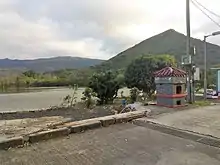



Yim Tso Ha (Chinese: 鹽灶下) is an area and a village in Sha Tau Kok, North District, Hong Kong.
Administration
Yim Tso Ha is a recognized village under the New Territories Small House Policy.[1] It is one of the villages represented within the Sha Tau Kok District Rural Committee. For electoral purposes, Yim Tso Ha is part of the Sha Ta constituency, which is currently represented by Ko Wai-kei.[2][3]
History
The villages of Ma Tseuk Leng (upper and lower), Yim Tso Ha, Wu Shek Kok and Au Ha formed a yeuk (約),[4] a form of oath-sworn, inter-village, mutual-aid alliance.[5]
At the time of the 1911 census, the population of Yim Tso Ha was 47. The number of males was 18.[6]
Features
There is a Hip Tin temple in Yim Tso Ha.
Fauna
In the past, Yim Tso Ha was the site of an egretry, with the earliest records dating back to 1958. The egretry has been abandoned since 1993 and it is believed that the birds that used to breed there have moved to A Chau. The Yim Tso Ha egretry was the first Site of Special Scientific Interest (SSSI) in Hong Kong, listed in 1975. At that time, it was the most important egretry in Hong Kong.[7] Having been abandoned for a long period of time, the Yim Tso Ha Egretry SSSI was de-listed in March 2016.[8]
See also
References
- ↑ "List of Recognized Villages under the New Territories Small House Policy" (PDF). Lands Department. September 2009.
- ↑ "Recommended District Council Constituency Areas (North District)" (PDF). Electoral Affairs Commission. Retrieved 19 October 2021.
- ↑ "North District Council - North DC Members". District Council. Retrieved 19 October 2021.
- ↑ Faure, David (1986). The structure of Chinese rural society: lineage and village in the eastern New Territories, Hong Kong. Oxford University Press. p. 217. ISBN 9780195839708.
- ↑ Hase, Patrick H. (2013). Custom, Land and Livelihood in Rural South China: The Traditional Land Law of Hong Kong's New Territories, 1750-1950. Royal Asiatic Society Hong Kong Studies Series. Hong Kong University Press. p. 10. ISBN 978-988-8139-08-8.
- ↑ Hase, Patrick (1996). "Traditional Life in the New Territories: The Evidence of the 1911 and 1921 Censuses" (PDF). Journal of the Royal Asiatic Society Hong Kong Branch. 36: 77. ISSN 1991-7295.
- ↑ "Hong Kong Biodiversity", Issue No. 14 March 2007
- ↑ Agriculture, Fisheries and Conservation Department Annual Report 2015-2016